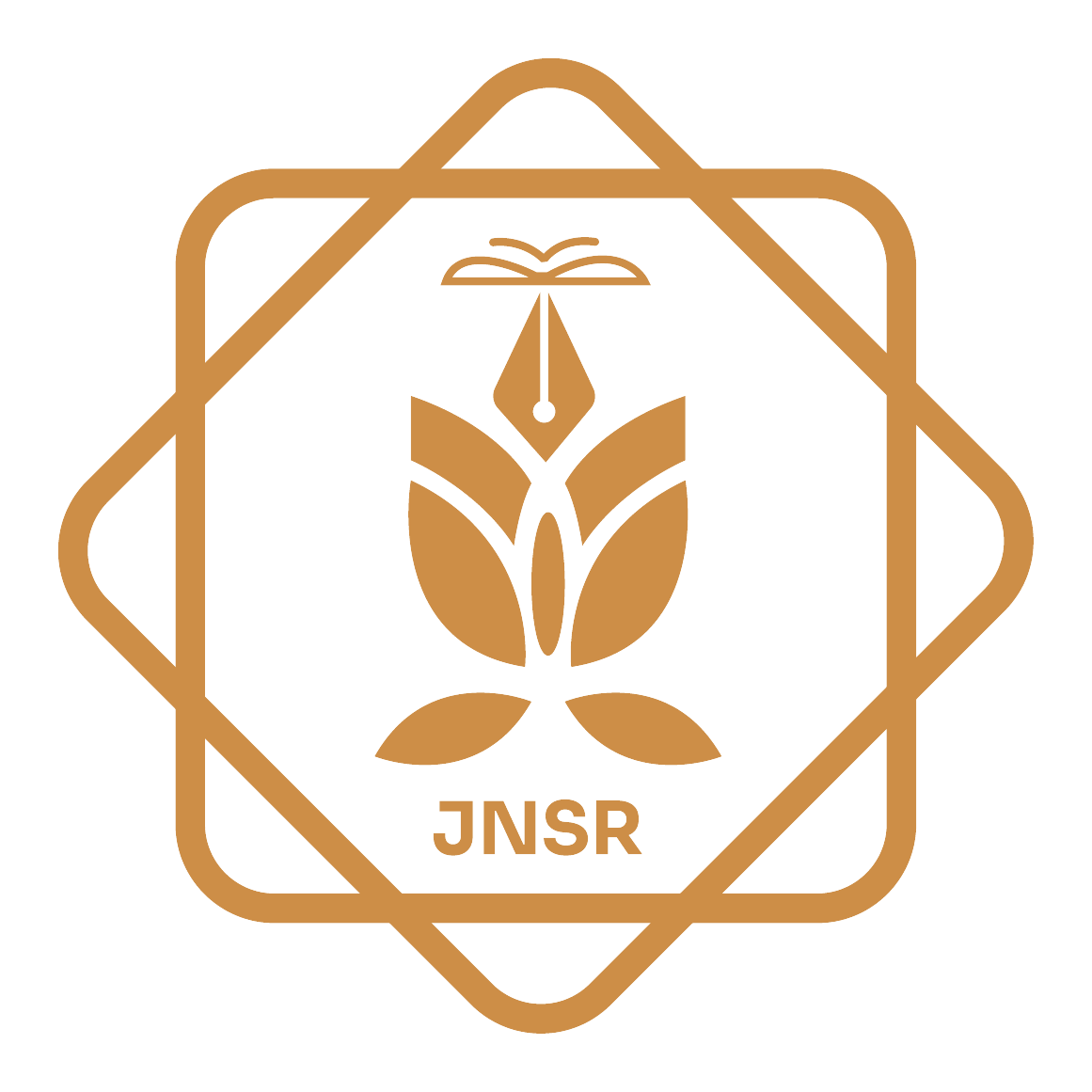Paper Submission Guide
Submission of an article implies that the work described has not been published previously (except in the form of an abstract or as part of a published lecture or academic thesis), that it is not under consideration for publication elsewhere, that its publication is approved by all authors and tacitly or explicitly by the authorities responsible where the work was carried out. However, we accept submissions that have previously appeared on preprint servers (for example: arXiv, bioRxiv, Nature Precedings, Philica, Social Science Research Network, and Vixra); have previously been presented at conferences; or have previously appeared in other “non-journal” venues (for example: blogs or posters). Authors are responsible for updating the archived preprint with the journal reference (including DOI) and a link to the published articles on the appropriate journal website upon publication.
Copyrights for articles are retained by the authors, with first publication rights granted to the journal. Authors have rights to reuse, republish, archive, and distribute their own articles after publication. The journal/publisher is not responsible for subsequent uses of the work. Authors shall permit the publisher to apply a DOI to their articles and to archive them in databases and indexes.
The publisher and journals have a zero-tolerance plagiarism policy. We check the issue using two methods: a plagiarism prevention tool (Turnitin) and a reviewer check. All submissions will be checked by Turnitin before being sent to reviewers.
Manuscripts should be prepared in Microsoft Word format (based on the requirement of different journals) and submitted online. The editors reserve the right to edit or otherwise alter all contributions, but authors will receive proofs for approval before publication. If you have any questions, please contact the editor of the journal.
General Requirements
Language and Numbers
Please write your text in proper English; American or British usage is accepted, but not a mixture of both. When writing numbers, use a period, not a comma, to represent the decimal point and a space to separate numbers of more than five digits into groups of three, whether on the left or the right of the decimal point (i.e., 10 000.471 85, but 1000.4718). We only accept manuscripts written in English.
Length of Paper
Papers between 4,500 and 10,000 words are preferred .
Title Page
To ensure the integrity of the peer review process, every effort should be made to prevent the identities of the authors and reviewers from being known to each other.
When you upload a submission file, author identities should be removed from it. You should upload the title page as a supplementary file for the editor to review.
Title
Be concise and informative. The title is often used in information-retrieval systems and should be no more than 15 words in length and not contain abbreviations or words that serve no purpose. If you choose to have a subtitle, it should be italicized and centered directly below the main title.
Authors’ Names and Affiliations
The preferred form of an author’s name is first name, middle initial(s), and last name; this form reduces the likelihood of mistaken identity. To assist researchers as well as librarians, use the same form for publication throughout your career; that is, do not use initials on one manuscript and your full name on a later one. Determining whether Juanita A. Smith is the same person as J. A. Smith, J. Smith, or A. Smith can be difficult, particularly when citations span several years and institutional affiliations. Omit all titles (e.g., Dr., Professor) and degrees (e.g., PhD, PsyD, EdD).
The authors’ affiliation identifies the location of the author(s) at the time the research was conducted, which is usually an institution. Include a dual affiliation only if two institutions contributed substantial support to the study. Include no more than two affiliations per author. If an author has no institutional affiliation, list the city and state of his/her residence. The names of the authors should appear in the order of their contributions, centered between the side margins. For names with suffixes (e,g., Jr. and II), separate the suffix from the rest of the name with a space instead of a comma. Only provide a complete mailing address of the corresponding author for correspondence.
Example:
Anne Smith1, Mary A. Meade1,2, David Wolf II1 & Charles Rockefeller Jr.2
1 Faculty of Economics, Kabul University, Kabul, Afghanistan
2 School of Economics, Peking University, Beijing, China
Correspondence: David Wolf II, School of Management, Northern Canada University, Toronto, Ontario, M3A 2K7, Canada. Tel: 1-613-947-3592. E-mail: davidwolf@gc.ca
Preparation of Text
Manuscripts should be organized in the following order:
Title; abstract; keywords (indexing terms, normally three-to-six items); introduction; material studied, area descriptions, methods and/or techniques; results; discussion; conclusion; acknowledgements; references.
General Rules for Text
Please use the following rules for the entire text, including abstract, keywords, headings, and references.
Font: Corbel; Size: 12 pt.
Paragraph Spacing: Above paragraph — 0 pt.; below paragraph — 6 pt.
Line Spacing: fixed, 12 pt.
Heading 1: Corbel; 14pt.; Bold; for example, First-level Heading
Heading 2: Corbel; 12pt.; Bold; for example, Second-level Heading
Heading 3: Corbel; 12pt.; Bold & Italic for example, Third-level Heading
Abstract
A concise and factual abstract is required. It should be between 150 and 250 words. The abstract should state briefly the purpose of the research, the principal results, and major conclusions. An abstract is often presented separately from the article, so it must be able to stand alone. References should therefore be avoided, but, if essential, they must be cited in full in the abstract without relying on the reference list.
Keywords
Immediately after the abstract, provide 3-10 keywords in alphabetical order, avoiding general and plural terms and multiple concepts (e.g., “and,” “of”). Be sparing with abbreviations: only abbreviations firmly established in the field may be eligible. Listing your keywords will help researchers find your work in databases.
Subdivision of the Article
Divide your article into clearly defined and numbered sections (e.g., 1., 2., 3., etc.). Subsections should be numbered 1.1, 1.2, etc., and sub-subsections should be numbered 1.1.1, 1.1.2, etc. Note that the abstract is not included in section numbering. Use this numbering also for internal cross-referencing: do not just refer to “the text.” Any subsection, ideally, should not be more than 600 words. Authors are urged to write as concisely as possible but not at the expense of clarity.
Equations
The text size of equations should be similar to normal text size. The formula should be placed center justified with serial number on the right. For example:
a=[(1+b)/x]1/2 (1)
Tables
Number tables consecutively in accordance with their appearance in the text. Place a table’s caption above the table’s body and its description below the body. Avoid vertical rules. Be sparing in the use of tables and ensure that the data presented in tables do not duplicate results described elsewhere in the article.
For example:
Table 1. Estimated Distance (cm) for Letter and Digit Stimuli
|
|
|
95%CI |
|
|
Condition |
M(SD) |
LL |
UL |
|
Letters |
14.5(28.6) |
5.4 |
23.6 |
|
Digits |
31.8(33.2) |
21.2 |
42.4 |
Note. CI=confidence; LL=lower limit, UL=upper limit.
You may resize the tables to fit the page size.
Figures and Schemes
Number figures consecutively in accordance with their appearance in the text. Place a figure’s caption and description below the figure body. A minimum resolution of 300 DPI is required. You may resize the figures or schemes to fit the page size.
Note. Avoid abbreviating the titles of tables, figures, and equations (i.e., Tab. 1, Fig. 2, Eq. 3) in the caption or in running text. Do not write “the table above/below” or “the figure on page 32,” because the position and page number of a table or figure cannot be determined until the pages are typeset.
References
Cite the work of those individuals whose ideas, theories, or research have directly influenced your work. They may provide key background information, support or dispute your thesis, or offer critical definitions and data. Citation of an article implies that you have personally read the cited work. In addition to crediting the ideas of others that you used to build your thesis, provide documentation for all facts and figures that are not considered common knowledge.
Citations in the Text
Each reference cited in the text must appear in the reference list, and each entry in the reference list must be cited in the text. However, two kinds of material are cited only in the text: references to classical works such as the Bible and the Qur’an, whose sections are standardized across editions, and references to personal communication. References in a meta-analysis are not cited in-text unless they are also mentioned in the text.
When formatting an in-text citation, give, in parentheses, the last name of the author of the cited work and the year it was published. For unpublished or informally published works, give the year the work was produced. Write “in press” in parentheses for articles that have been accepted for publication but that have not yet been published. Do not give a date until the article has actually been published.
In all other instances, citations in the text should follow the referencing style used by the American Psychological Association.
Examples:
- A Work by Two Authors
Name both authors in the signal phrase or in the parentheses each time you cite the work. Use the word “and” between the authors’ names within the text; use the ampersand in the parentheses.
Research by Wegener and Petty (1994) supports...
(Wegener & Petty, 1994)
- A Work by Three to Five Authors
List all the authors in the signal phrase or in parentheses the first time you cite the source.
(Kernis, Cornell, Sun, Berry, & Harlow, 1993)
In subsequent citations, only use the first author’s last name followed by “et al.” in the signal phrase or in parentheses.
(Kernis et al., 1993)
- Six or More Authors
Use the first author’s last name followed by et al. in the signal phrase or in parentheses.
Harris et al. (2001) argued...
(Harris et al., 2001)
- Authors with the Same Last Name
To prevent confusion, use first initials when citing two or more authors with the same last name.
(E. Johnson, 2001; L. Johnson, 1998)
- Unknown Author
If the work does not have an author, cite the source by its title in the signal phrase or use the first word or two in the parentheses. Titles of books and reports are italicized; titles of articles, chapters, and Web pages are put in quotation marks.
A similar study was done of students learning to format research papers.
Note: In the rare case that “Anonymous” is used for the author, treat it as the author’s name in parentheses and the reference page.
(Anonymous, 2001)
- Organization as an Author
If the author is an organization or a government agency, mention the organization in the signal phrase or in the parenthetical citation the first time you cite the source.
According to the American Psychological Association (2000), ...
If the organization has a well-known abbreviation, include the abbreviation in brackets behind the full name of the organization the first time the source is cited and then use only the abbreviation in later citations.
First citation: (Mothers Against Drunk Driving [MADD], 2000)
Second citation: (MADD, 2000)
Citing and Listing of Web References
As a minimum, the full URL should be given. Any further information (author names, dates, reference to a source publication, etc.), if known, should also be given. Web references can be listed separately (e.g., after the reference list) under a different heading if desired, or they can be included in the reference list.
Reference List
Please find the below information for basic rules in a reference list.
- Each entry in your reference list should be defined by a hanging indent of two characters.
- Authors’ names are inverted (last name first); give the last name and initials for all authors of a particular work if it has three to seven authors. If the work has more than seven authors, list the first six authors and then use ellipses after the sixth author’s name. After the ellipses, list the last author’s name of the work. Use “&” instead of “and” when listing multiple authors of a single work.
- Reference list entries should be alphabetized by the last name of the first author of each work.
- If you have more than one article by the same author, single-author references or multiple-author references with the exact same authors in the exact same order are listed in order by the year of publication, starting with the earliest.
- Capitalize all major words in journal titles.
- When referring to any work that is not a journal, such as a book, article, or Web page, capitalize only the first letter of the first word of a title and subtitle, the first word after a colon or a dash in the title, and proper nouns. Do not capitalize the first letter of the second word in a hyphenated compound word.
DOIs in References
The journal/publisher encourages authors to cite those items (journal articles, conference proceedings, book chapters, technical reports, working papers, dissertations, etc.) that have DOIs. When the cited items have DOIs, the authors should add DOI persistent links to the regular references. The DOI persistent links should be the last elements in the references. The persistent links should be active.
Format of persistent link: https://doi.org/+DOI
Example of persistent link: https://doi.org/10.1109/2.901164
The authors or editors may retrieve articles’ DOIs at http://www.crossref.org/SimpleTextQuery/.
You can register a free account to start retrieving articles’ DOIs. CrossRef allows you to check multiple references. Please read this webpage very carefully. Only articles with assigned DOIs can be retrieved through this webpage.
References Examples
Books
- Book with one author
Bernstein, T. M. (1965). The careful writer: A modern guide to English usage (2nd ed.). New York, NY: Atheneum.
- Electronic book
Replace place-of-publication and publisher information with the DOI.
Anderson, C. A., Gentile, D. A., & Buckley, K. E. (2007). Violent video game effects on children and adolescents: Theory, research and public policy. https://doi.org/10.1093/acprof:oso /9780195309836.001.0001
Note: Insert a blank space if you need to break a URL across lines before most punctuation. Do not add a period after the URL.
- Work with two authors
Beck, C. A. J., & Sales, B. D. (2001). Family mediation: Facts, myths, and future prospects. Washington, DC: American Psychological Association. https://doi.org/10.1037/10401-000
- Two or more works by the same author
Arrange by the year of publication, the earliest first.
Postman, N. (1979). Teaching as a conserving activity. New York, NY: Delacorte Press.
Postman, N. (1985). Amusing ourselves to death: Public discourse in the age of show business. New York, NY: Viking.
If works by the same author are published in the same year, arrange alphabetically by title and distinguish the documents by adding a lowercase letter after the year of publication as indicated below.
McLuhan, M. (1970a). Culture is our business. New York, NY: McGraw-Hill.
McLuhan, M. (1970b). From cliché to archetype. New York, NY: Viking Press.
- Book by a corporate author
Associations, corporations, agencies, government departments, and organizations are considered authors when there is no single author.
American Psychological Association. (1972). Ethical standards of psychologists. Washington, DC: American Psychological Association.
- A book with no author or editor listed
Merriam-Webster’s collegiate dictionary (10th ed.). (1993). Springfield, MA: Merriam-Webster.
- A translated work and/or a republished work
Laplace, P. S. (1814/1951). A philosophical essay on probabilities (F. W. Truscott & F. L. Emory, Trans.). New York: Dover.
Anthologies, Course Packs, & Encyclopedias
- Anthology or compilation
Gibbs, J. T., & Huang, L. N. (Eds.). (1991). Children of color: Psychological interventions with minority youth. San Francisco, CA: Jossey-Bass.
- Work in an anthology or an essay in a book
Bjork, R. A. (1989). Retrieval inhibition as an adaptive mechanism in human memory. In H. L. Roediger III, & F. I. M. Craik (Eds.), Varieties of memory & consciousness (pp. 309-330). Hillsdale, NJ: Erlbaum.
- Work in a course pack
Goleman, D. (2009). What makes a leader? In D. Demers (Ed.), AHSC 230: Interpersonal communication and relationships (pp. 47-56). Montreal, Canada: Concordia University Bookstore. (Reprinted from Harvard Business Review, 76(6), pp. 93-102, 1998).
- Article in a reference book or an entry in an encyclopedia
If the article/entry is signed, include the author’s name; if unsigned, begin with the title of the entry
Guignon, C. B. (1998). Existentialism. In E. Craig (Ed.), Routledge encyclopedia of philosophy (Vol. 3, pp. 493-502). London, England: Routledge.
Articles
- Article in a journal––for articles retrieved online
Mellers, B. A. (2000). Choice and the relative pleasure of consequences. Psychological Bulletin, 126, 910-924. https://doi.org/10.1037/0033-2909.126.6.910
Note: List only the volume number if the periodical uses continuous pagination throughout a particular volume. If each issue begins with page 1, then list the issue number as well.
Klimoski, R., & Palmer, S. (1993). The ADA and the hiring process in organizations. Consulting Psychology Journal: Practice and Research, 45(2), 10-36.
https://doi.org/10.1037/1061-4087.45.2.10
- Articles in a journal, more than seven authors
Gilbert, D. G., McClernon, J. F., Rabinovich, N. E., Sugai, C., Plath, L. C., Asgaard, G., ... Botros, N. (2004). Effects of quitting smoking on EEG activation and attention last for more than 31 days and are more severe with stress, dependence, DRD2 A 1 allele, and depressive traits. Nicotine and Tobacco Research, 6, 249-267. https://doi.org/10.1 080/1462220041 0001676305
- Article in a newspaper or magazine
Semenak, S. (1995, December 28). Feeling right at home: Government residence eschews traditional rules. Montreal Gazette, p. A4.
Schwartz, J. (1993, September 30). Obesity affects economic, social status. The Washington Post, pp. A1, A4.
Driedger, S. D. (1998, April 20). After divorce. Maclean’s, 111(16), 38-43.
- Article from an electronic source
Zhao, S., Grasmuck, S., & Martin, J. (2008). Identity construction on Facebook: Digital empowerment in anchored relationships. Computers in Human Behavior, 24(5), 1816-1836. https://doi.org/10.1016/j.chb.2008.02.012
URL for an online periodical:
Cooper, A., & Humphreys, K. (2008). The uncertainty is killing me: Self-triage decision making and information availability. E-Journal of Applied Psychology, 4(1). Retrieved from http://ojs.lib.swin.edu.au/index.php/ejap/article/view/124/129
Cress, C. M. (2009). Curricular strategies for student success and engaged learning [PowerPoint slides]. Retrieved from http://www.vtcampuscompact.org/2009/TCL_post/presenter_powerpoints /Christine%20Cress%20-%20Curricular%20Strategies.ppt
Doctoral Dissertations and Master’s Theses
- Unpublished theses and dissertations
Jordan, J. J. (2005). Psychosocial effects of gifted programming (Unpublished master’s thesis). University of Saskatchewan, Saskatoon, Canada.
Berg, D. H. (2003). Prospective leadership development in colleges and universities in Canada: Perceptions of leaders, educators and students (Unpublished doctoral dissertation). University of Saskatchewan, Saskatoon, Canada.
- Electronic theses and dissertations
Hiebert, R. W. (2006). The education of children from poverty: A descriptive case study of a public school and a community school (Doctoral dissertation). Available from ProQuest Dissertation & Theses: Full Text (NR18185).
Richet, E. (2007). The citizenship education system in Canada from 1945-2005: An overview and assessment (Master’s thesis, University of Saskatchewan, Saskatoon, Canada). Retrieved from http://library2.usask.ca/etd
Meetings and Symposia
- Proceedings published in a book form
McKay, G. (1999). Self-determination in Aboriginal education. In L. B. Muller (Ed.), Changing the climate: Proceedings of the 1998 Conference for Graduate Students in the Social Sciences and Humanities (pp. 1-11). Saskatoon, Canada: University of Saskatchewan.
- Proceedings published regularly online
Herculano-Houzel, S., Collins, C. E., Wong, P., Kaas, J. H., & Lent, R. (2008). The basic nonuniformity of the cerebral cortex. Proceedings of the National Academy of Sciences, 105, 12593-12598. https://doi.org/10.1073/pnas.0805417105
- Paper presentation or poster session
Liu, S. (2005, May). Defending against business crises with the help of intelligent agent based early warning solutions. Paper presented at the Seventh International Conference on Enterprise Information Systems, Miami, FL. Abstract retrieved from http://www.iceis.org/iceis2005/abstracts_2005.htm
Multimedia
- Television or radio program
MacIntyre, L. (Reporter). (2002, January 23). Scandal of the century [Television series episode]. In H. Cashore (Producer), The fifth estate. Toronto, Canada: Canadian Broadcasting Corporation.
- Film, video recording or DVD
Kubrick, S. (Director). (1980). The shining [Motion picture]. United States: Warner Brothers.
- Online lecture notes and presentation slides (such as Moodle)
Cress, C. M. (2009). Curricular strategies for student success and engaged learning [PowerPoint slides]. Retrieved from http://www.vtcampuscompact.org/2009/TCL_post/presenter_powerpoints /Christine%20Cress%20-%20Curricular%20Strategies.ppt
Web pages
- Web pages and non-periodical documents on the Internet
Library and Archives Canada. (2008). Celebrating women’s achievements: Women artists in Canada. Retrieved from http://www.collectionscanada.gc.ca/women/002026-500-e.html
Geography of Canada. (2009, September 29). In Wikipedia, the free encyclopedia. Retrieved September 30, 2009, from http://en.wikipedia.org/wiki/Geography_of_Canada
Note
Please avoid using footnotes. Change footnotes to endnotes. Insert “(Note 1, Note 2)” in the running text and explain the note in an end notes section after the references page. Please see the template (http://ccsenet.org/web/submissionguide) for examples.
Appendix
The appendix comes after the references and the notes. In the text, refer to appendices by their labels: e.g., produced the same results for both studies (see Appendices A and B for complete proofs). Please see the template (www.asr.org/submission) for examples.





















